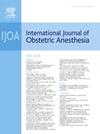产后喉罩输卵管结扎与气管插管后肺部并发症的回顾性队列研究(2012-2024)
IF 2.3
3区 医学
Q2 ANESTHESIOLOGY
引用次数: 0
摘要
背景:由于存在误吸的风险,全麻气管插管是产科患者的标准选择。然而,气管内插管具有手术相关的风险,促使人们对喉罩作为替代或抢救装置的兴趣。支持其用于产后输卵管结扎的证据仍然有限。方法回顾性队列研究,选取2012 - 2024年在某高危产科中心行产后输卵管结扎术的患者。患者根据使用的气道设备进行分组:喉罩或气管插管,包括需要转换的患者。主要终点是术后7天内呼吸系统并发症的发生率,包括肺炎、呼吸衰竭、麻醉相关反应和其他重大不良事件。二次分析包括人口统计学和产科特征。结果全麻1095例,气管插管503例(46%),声门上气道592例(54%)。两组患者均未出现呼吸系统并发症;基于泊松的置信区间证实,发病率的上限仍然为1%。声门上气道的患者更有可能是ASA I(34%对21%),2.6%的患者转换为气管插管。气管插管组的中位体重指数较高(29.7 vs 29.2 kg/m2, P = 0.027)。结论回顾性分析全麻下输卵管结扎术后两种气道装置均无呼吸系统并发症。在精心挑选的患者中,声门上气道装置似乎是一种安全的选择。本文章由计算机程序翻译,如有差异,请以英文原文为准。
Pulmonary complications following postpartum tubal ligation with laryngeal mask vs. endotracheal intubation: a retrospective cohort study (2012–2024)
Background
General anesthesia with endotracheal intubation is standard in obstetric patients due to the risk of aspiration. However, endotracheal intubation carries procedure-related risks, prompting interest in laryngeal masks as alternative or rescue devices. Evidence supporting their use in postpartum tubal ligation remains limited.
Methods
A retrospective cohort study was conducted at a high-risk obstetric center, including patients who underwent postpartum tubal ligation between 2012 and 2024. Patients were grouped according to the airway device used: laryngeal mask or endotracheal intubation, including those who required conversion. The primary outcome was the incidence of respiratory complications, including pneumonia, respiratory failure, anesthesia-related reactions, and other significant adverse events, within seven postoperative days. Secondary analyses included demographic and obstetric characteristics.
Results
There were 1,095 cases performed under general anesthesia, 503 (46 %) received endotracheal intubation and 592 (54 %) supra-glottic airway. No respiratory complications were observed in either group; Poisson-based confidence intervals confirmed that the upper bound of incidence remained < 1 %. Patients with supra-glottic airway were more likely to be ASA I (34 % vs. 21 %), and 2.6 % had conversion to endotracheal intubation. Patients with endotracheal intubation had a higher median body mass index (29.7 vs. 29.2 kg/m2, P = 0.027).
Conclusion
In this retrospective analysis of postpartum tubal ligation under general anesthesia, there were no respiratory complications with either airway device. Supraglottic airway devices appear to be a safe alternative in carefully selected patients.
求助全文
通过发布文献求助,成功后即可免费获取论文全文。
去求助
来源期刊
CiteScore
4.70
自引率
7.10%
发文量
285
审稿时长
58 days
期刊介绍:
The International Journal of Obstetric Anesthesia is the only journal publishing original articles devoted exclusively to obstetric anesthesia and bringing together all three of its principal components; anesthesia care for operative delivery and the perioperative period, pain relief in labour and care of the critically ill obstetric patient.
• Original research (both clinical and laboratory), short reports and case reports will be considered.
• The journal also publishes invited review articles and debates on topical and controversial subjects in the area of obstetric anesthesia.
• Articles on related topics such as perinatal physiology and pharmacology and all subjects of importance to obstetric anaesthetists/anesthesiologists are also welcome.
The journal is peer-reviewed by international experts. Scholarship is stressed to include the focus on discovery, application of knowledge across fields, and informing the medical community. Through the peer-review process, we hope to attest to the quality of scholarships and guide the Journal to extend and transform knowledge in this important and expanding area.

 求助内容:
求助内容: 应助结果提醒方式:
应助结果提醒方式:


